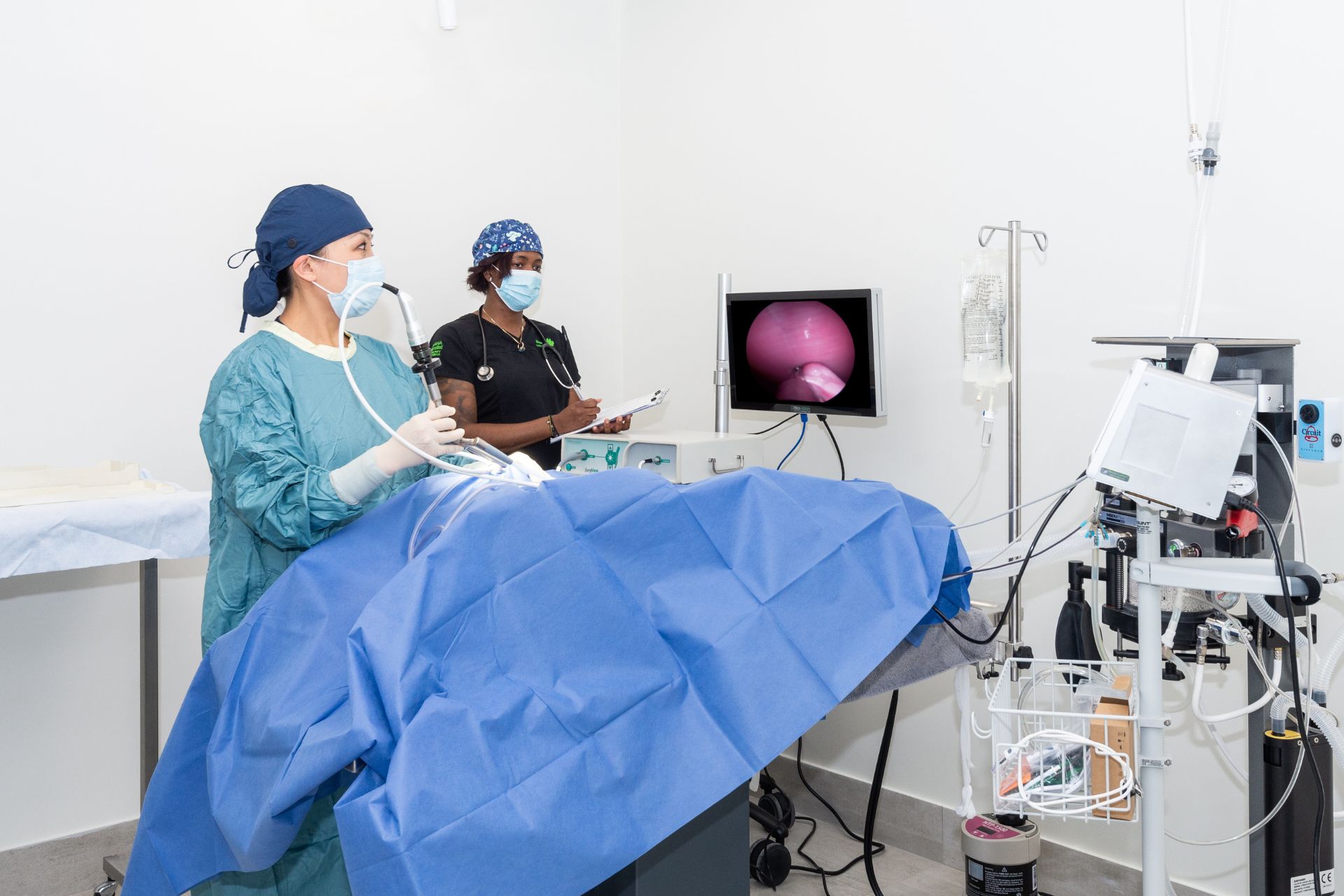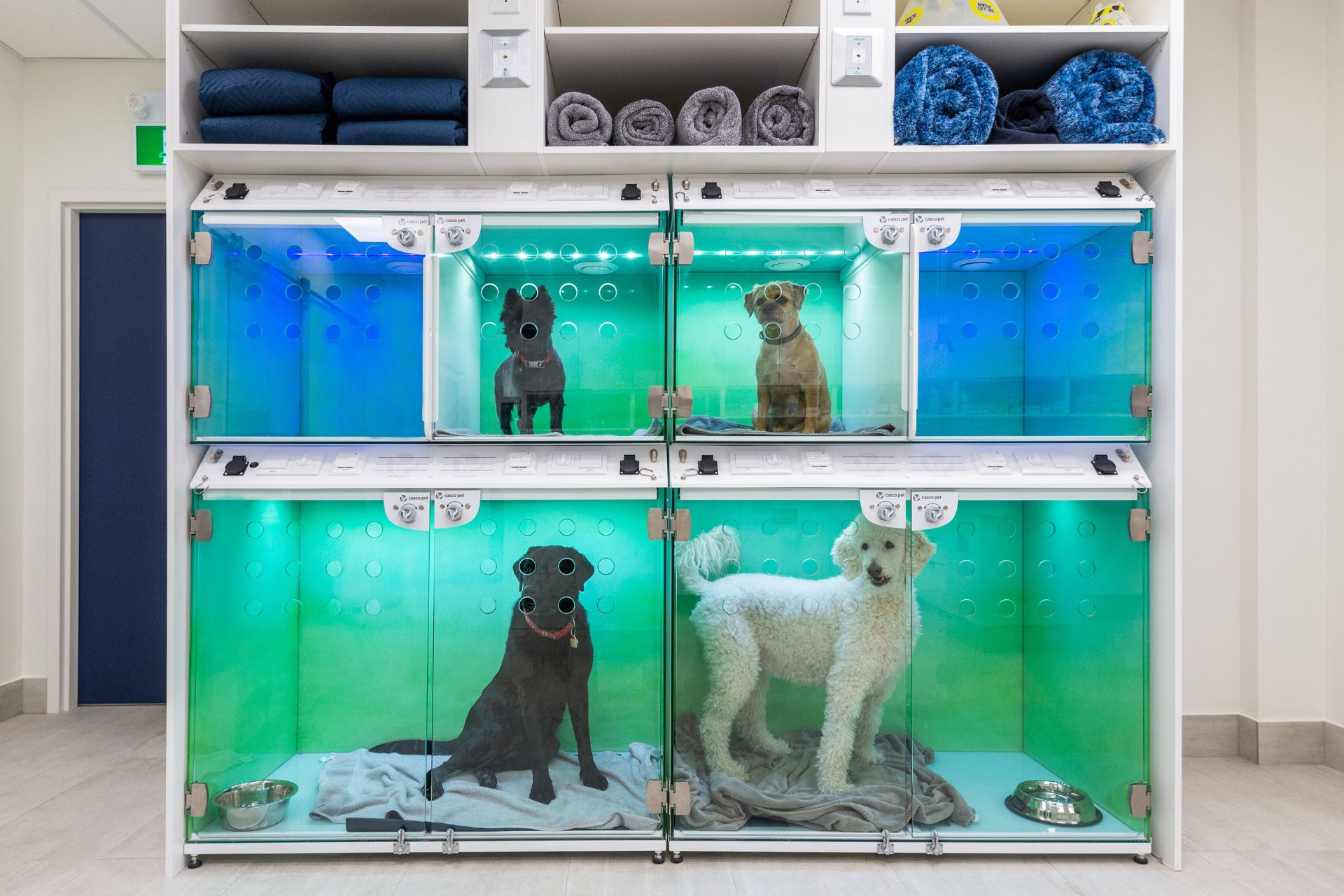Laparoscopic Spays: Your Questions Answered

We perform our dog spays laparoscopically – also known as minimally invasive or keyhole surgery because it requires only a small incision into the abdomen. The laparoscope used for this surgery is a slim tubular instrument outfitted with a light source, a camera, and a channel for inserting slim surgical instruments. The camera relays video footage of inside the abdomen to an external computer monitor. Laparoscopy significantly improves our ability to see internal organs and makes it easier and safer for a surgeon to operate. This document answers common questions pet owners have about the surgery.
Note: We can also perform a laparoscopic-assisted gastropexy at the time of a spay to prevent a condition called gastric dilatation-volvulus for at-risk breeds (typically large, deep-chested dogs). For more information, see our handout “Prophylactic Gastropexy: Preventing Gastric Dilatation-Volvulus.”
Why choose a laparoscopic spay?
Compared to a traditional spay surgery, spays performed laparoscopically have the following advantages:
- Less invasive – a single, small incision (about 1.5 cm) is made rather than the larger (6-15 cm) incision required for a traditional spay
- Faster Recovery – your pet will be back to her normal activity in about 3-5 days instead of the 10-14 days of rest required for a traditional spay
- Shorter time under anesthesia
- Less bleeding, bruising, and pain – a smaller incision, better visualization, and built-in cutting/cauterizing technology make for a cleaner and quicker operation with less trauma to tissues
- Fewer post-op complications
What’s involved in a laparoscopic spay?
Once a patient is placed under general anesthesia, a single small incision is made into the abdomen. CO2 gas is then introduced through the incision to lift the body wall away from the internal organs, creating a domed effect so that those organs can be easily visualized. A laparoscope is then inserted into the incision, each ovary is anchored against the body wall, and the associated vessels are cauterized and cut. The ovaries and uterus are removed through the incision, the CO2 gas is released from the abdomen, and the incision is then stitched closed.
Our patients recover in our state-of-the art temperature- controlled Casco enclosures equipped with special recovery lighting to ensure a warm and restful recuperation from anesthesia.
Note: For the purposes of ensuring sterile technique during surgery, we shave both the abdomen and an area of fur that extends up both sides of the patient.

Can any dog be spayed laparoscopically?
Most healthy puppies and dogs are excellent candidates for laparoscopic surgery. Dogs that are more suited to a traditional spay include those that are very small (less than 3 kg) or dogs with suspected reproductive tract disease such as pyometra (a uterine infection) or cancer. Your veterinarian will advise whether laparoscopic surgery is appropriate for your pet.

How long will my dog be in hospital?
Your pet will be admitted (fasted) in the morning and will return home the same day in the evening.
Is there a benefit to removing the uterus along with the ovaries?
While we can remove just the ovaries and leave the uterus behind (an ovariectomy), there’s no particular advantage to doing so. We typical remove both ovaries and the uterus (ovariohysterectomy).
Does a laparoscopic spay cost more than a traditional spay?
Laparoscopic surgery costs a little more than a traditional spay because it requires specialized training and the use of highly specialised equipment that includes a high-end camera and computer monitor. The cost of the spay will depend on the size of your dog and whether you’ve requested any additional procedures. The extra cost of a laparoscopic spay is offset by the safety, comfort, and speed of recovery with fewer post-op complications.
Is there a downside to laparoscopic surgery?
Complications with this type of surgery are rare. In instances where there is poor visualization with the scope or bleeding that isn’t easily controlled with cautery (in a mature overweight dog, for example), a laparoscopic spay may be converted to traditional open surgery with no long-term consequences.
Can I have my dog spayed at SOVH if I’m not a regular client there?
Absolutely! We recognize that there aren’t many hospitals that offer this service, and we’re happy to help. We’ll need medical records to assess the health of your dog, and we’ll need to examine your pet to ensure she’s a good candidate for surgery.
Is a laparoscopic spay covered by insurance?
Most basic plans don’t cover spay surgery of any kind. Check with your insurance provider to see what your plan covers.
Can cats be spayed laparoscopically?
Yes, but unlike with dogs, there’s no documented advantage to spaying cats using this method over a traditional spay, and the size of the spay incision is comparable.




